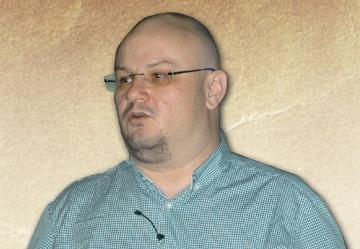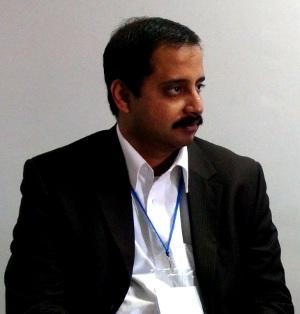
With initiatives like the Imagine Cup and PhoneGap Meetup, Microsoft is surely taking many steps forward to engage with open source communities across the globe, including India. At the sidelines of OSI Days 2011, Gianugo Rabellino, senior director of Open Source Communities, Microsoft, and Mandar Naik, director, Platform Strategy, Microsoft, spoke to Rahul Chopra, editor, LINUX For You, on Microsoft’s “openness” to open source, and its key strategies to befriend application developers for mobile platforms, the Azure project, et al.
LFY: This is your first trip to India. So far, how has the interaction been with the community here? Anything unique that struck you?
GR: A few days back, we were in front of roughly 300 people in Chennai and they were really looking forward to talking with us. We got bombarded with questions; it was a very lively audience.
Whenever I speak to the community here, I see the same enthusiasm as I see elsewhere in the world. I can see the same kind of aspirations here as I see anywhere else and that’s what keeps me going. That’s what moved me to be part of Open Source India too. I am seeing that kind of magic happening over here too.
LFY: Would you call this trip and your engagement at Open Source India as successful? What would be the parameters to measure the success?
GR: Yes, it has been a very successful event because I managed to meet a lot of people. It was about meeting the right seeds within the right people. I also met the developers and was able to understand what their aspirations and problems are. So I am taking away important lessons from this experience, like how they could support the community and that hard work is important. And of course, what counts is not the visit to the country, but the follow ups with local branches, the vendors, friends and corporate organisations.
LFY: Please elaborate on Microsoft’s involvement with open source. What has Microsoft’s open source strategy been?
GR: First, you have to recognise that Microsoft is a huge organisation. There are various businesses (divisions) at Microsoft which look at open source differently. Yes, Microsoft surely wants to be as ‘open’ as we can possibly get. Openness is a crucial part of the future IT strategies of every company out there.
In fact, I am still to be in a meeting (at Microsoft) where open source is being discussed as an issue. We see it as an opportunity (and not a challenge). Even within Microsoft, we feel that open source is one of the key ways in which the software fabric works.
LFY: Is your open source association restricted to the Azure platform only?
GR: No, it goes way beyond Azure. However, it is surely an important example of the way in which we have been engaging with the open source community since a long time.
Now, when a lot of developers work on the Web, they are mostly interested in the server side; this is why most of them are talking about Azure and about our servers.
LFY: On the mobile front, two popular platforms are iOS and Android. While the former is totally closed, the other is mostly open. And then comes your platform, which is basically a closed platform with some “branch outs” for the open source community. In such a scenario, what would be your message to the open source community with respect to going open?
GR: Well, what I would like them (mobile developers) to know is that we are welcoming them with open arms. And, we are putting in a lot of effort to help them build new exciting mobile applications for Windows phones.
Let me give you a few examples — we recently talked about PhoneGap which allows you to develop software for all popular mobile platforms including iPhone, Android, Blackberry, Symbian and Palm. If you are a developer, you just want to build a single solution that can run on different devices. PhoneGap solves that problem.
Plus, we also want developers to be aware of the link between PhoneGap and the Windows framework, and we accomplish this by sharing guidelines, white papers and tutorials for iOS, Android and Symbian developers.
We recently came up with an API mapping guide, which is basically a tool that will allow iOS or Android developers access to the nitty-gritty of not only developing apps easily for the Windows 7 framework, but also porting their existing iOS or Android apps to the Windows framework.
LFY: In the Android or the Google ecosystem, a competitive spirit is encouraged with initiatives like motivating developers to go open whenever they want. Does Microsoft practice anything like this?
GR: Not that I know of, but I admit it’s a great idea. However, I am aware of some initiatives that are about engaging with developers and motivating them to write apps for the Windows platform. One of these, which I would really like to mention, is the Imagine Cup.
Through this competition we target the students community and our message to them is: “You are the ones who probably have the gears to change the world, to address the big social issues, to change the big picture. Go wild. You are free to think of anything that uses our technology or somebody else’s technology. Just share the idea with us; it will be judged by your peers, experts, technologists, etc, and there will be winners for different challenges.”
I think it’s an exciting event. Last year, I was involved as one of the members of the jury of the Imagine Cup, where we have various challenges, and where my team happened to be hosting the interoperability challenge. I think it’s always great to see people trying to do something new with passion.
LFY: In India, within the open source world, there has been a major transition from hostility towards Microsoft to accepting the firm as one more player with respect to open source. At the global level, do you observe the community harbouring any apprehensions towards Microsoft?
GR: Well, the answer is twofold. In fact, based on my interaction with the open source community all these years, I can say that the open source community is very approachable. So when you reach out to the community of developers in the open community, you realise they bring along with them their culture of exploration and seeking solutions to problems. When we work with them, we adapt to this culture. Frankly, I’m yet to see a community that does not want to work with us.
As far as particular problems are concerned, my experience so far has been that in general, people are willing to talk to us and, more than that, people are looking forward to having a technical discussion on how they can make things better, how they could work on building a solution, use our technology, etc.
So we have evolved many ways of helping and of being more open with the open source community.
LFY: Are you as open to working with small open source communities, as you are with the communities related to large projects like Ruby on Rails and PHP? How do the smaller projects engage Microsoft?
GR: That’s exactly what my job is all about! I am the person to reach out to for all open source communities. I’ll be more than happy to assist them. It’s essentially why I get my salary. The more the projects engage with us, the better it is. And we always are open to finding a way forward to help them.
LFY: Mandar, correct me if I am wrong, but are you the contact point for the Indian open source community to engage with, at Microsoft?

MN: Absolutely. I am the single point of contact for anyone trying to reach out to Microsoft in India for open source related issues. Obviously, I have global support from Gianugo and the team, so it would be great if open source enthusiasts reached out to us. My email address is mandar.naik_at_microsoft.com, and they can reach me directly. I will try to help them out as quickly as possible.
LFY: Not many open source projects are being initiated in India, despite the fact that Indians are increasingly deploying open source. Do you find these communities reaching out from India?
MN: When we participated at Open Source India last year, we launched quite a few development tools. There were a lot of open source contributors from the Indian market too, who participated. And there were global companies also, apart from Indian companies, that participated.
However, let me point out that the open source community in India is more consumption oriented. I think it is up to the community itself and up to people like you, representing the media, and to us to take this initiative forward. Because one little problem within India is, when people think about open source, they think about specific platforms. They need to realise that open source is about community development and it’s not about the economics. When that realisation dawns, we’ll see traction happening.
LFY: There have been some attempts to connect with the open source community of India through competitions. Can you share some details about this initiative?
MN: Last year, we launched a contest for open source developers through which we invited them to create applications and compete. That went really well. So we have had tremendous traction with developers wanting to do that.
LFY: Are you planning to repeat the competition in India this year?
MN: We definitely want to continue with the initiative. We want to make it an annual affair, if possible. This will help us establish a much more holistic culture to support the development process.
LFY: Last year, you had also launched an interesting engagement programme for developers to try out the Azure platform. How did that go? Did it meet your expectations?
MN: Well, yes and no. When I say yes, I mean that there was tremendous excitement. We saw a lot of developers enrolling for the facilities and toolkits. We could also reach out to a lot of open source developers and we got a lot of folks interested in working with us.
The flip side, however, was we realised that it is more of “our” thing. There’s a whole lot of expertise that is required to really get something meaningful done on a platform like Azure. There was a tremendous amount of restraint that we saw in many of the developers regarding what could be done on the Microsoft platform.
This feeling is now slowly going away and it actually takes a while because that was a platform we had just launched and people were not sure or aware of what they could do on Azure.
However, I think as we moved forward and owing to the amount of interaction that we have had over time with the communities, the comfort levels of developers working on the Azure platform have improved, tremendously.
LFY: Coming back to the Imagine Cup. Does this imply that you want ideas that are implemented on the Windows platform?
MN: Not at all. The Imagine Cup is for students in India and across the globe. It is actually being driven as part of our engagement with the student community to foster innovation in the student community. It isn’t really about anything to do with one specific platform or product.
It’s only the “idea” that is of paramount importance, and it is solely on the merit of the idea that it is actually judged. There obviously has to be an element of realisation of how and for what purpose it will be utilised.
LFY: Is India important for you (Microsoft) in terms of establishing a development base or industrial base?
GR: Can’t speak about the Microsoft perspective, but from my perspective — after spending 19 years of my life in this space and making sure that I have enough customers, I am happy to say that I am right now interacting both with developers and business decision makers. At the end of the day, to me, it is really about open source relationships.
Of course, India is a very important market as well as a development base for Microsoft. You’ve just got to believe that some things just go together and come one after another. If you have a great developer system, you are ready to adapt, and then will be able to build successful partnerships.
LFY: Does your team (open source) also engage with the CIOs and IT managers’ community?
GR: I have a team that is responsible for meeting a very select group of 50 or so top CIOs from Fortune 500 companies, once a year. However, this team, called the Customer Council, works throughout the year with them. The team was constituted a few years ago. It has been greatly effective in letting us know what the customers really want from us. So we have these very open dealings with people specifying, “We like this”, “We don’t like this”, “Go fix that up” and so on.
LFY: In the past interactions, the message that we got is that Microsoft is totally open to open source, but Linux as a platform is a competitor. Please comment.
GR: Let me clarify — we do not compete with Linux. If anything, we compete with Linux vendors, but it’s an important decision to make because our company doesn’t compete with a technology.
We have a healthy competition with Red Hat. We also have a healthy competition and collaboration with Novell SUSE.
It is important for us to keep our partnerships, and it is equally important for us to keep our market share growing. But having said that, it’s got nothing to do with the Linux community. We are happy that we are contributing to the Linux group.
LFY: And what about Android?
GR: I don’t look at Android per se; I definitely look at the Android developers’ community and this is something I want to reach out to. So we have porting apps, API mappings, toolkits, SDKs, and a lot more resources for Android developers to help them develop Android applications that could connect to Microsoft Azure. And these are free-of-cost resources!
LFY: So essentially, you are making it easy for them to migrate their mobile apps from Android to Azure?
GR: Not only that. Our main message is, “Stay on Android and build your apps on Android, but for your server platform, check out Azure — it could be the platform of your choice.”
LFY: In future, is there any chance of us seeing some strong open source products from Microsoft à la Android from Google?
GR: At this age, we are changing; we have become open, and this is all about business decisions and business cases — there are no fixed business models now.
I can give an example of something we announced recently. It was our commitment to the Apache and Hadoop groups. What we are going to do is not only offer the best-of-breed technology but work with the community, so whatever changes they make in the Windows server, we give it back to the community; and second, we maintain compatibility so that users of Hadoop can keep taking their jobs in and out the Windows server and Azure. That’s an important step forward. It’s a product.











































































[…] a “controlled opposition” approach to ingest the competition with lies and spin such as this. The key idea is, Microsoft needs to be able to control the message of all sides of the debate. […]